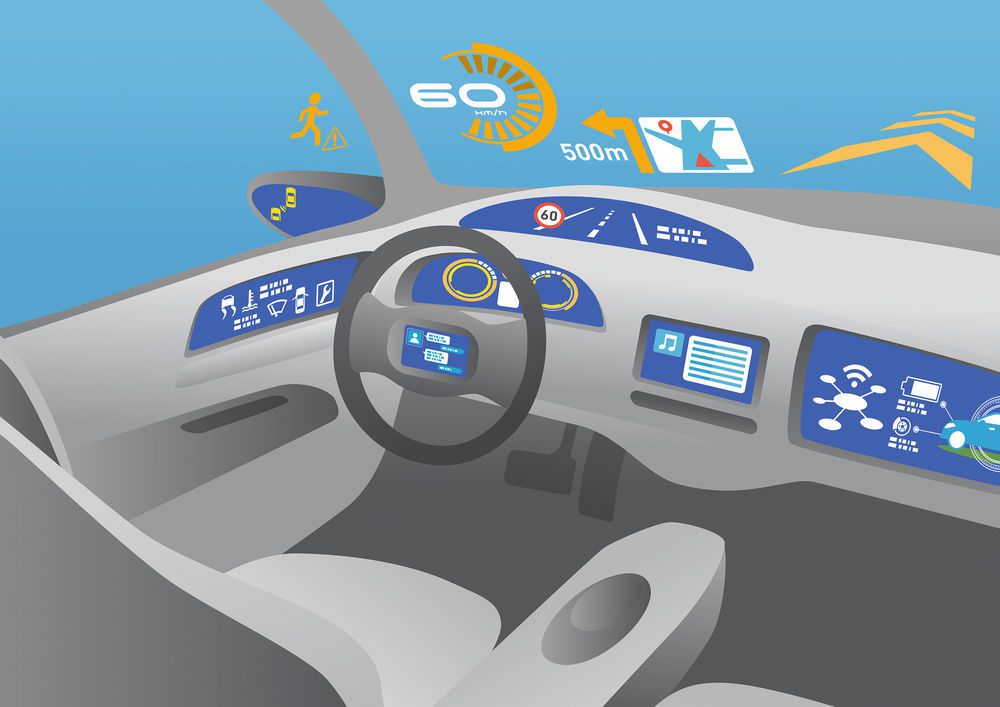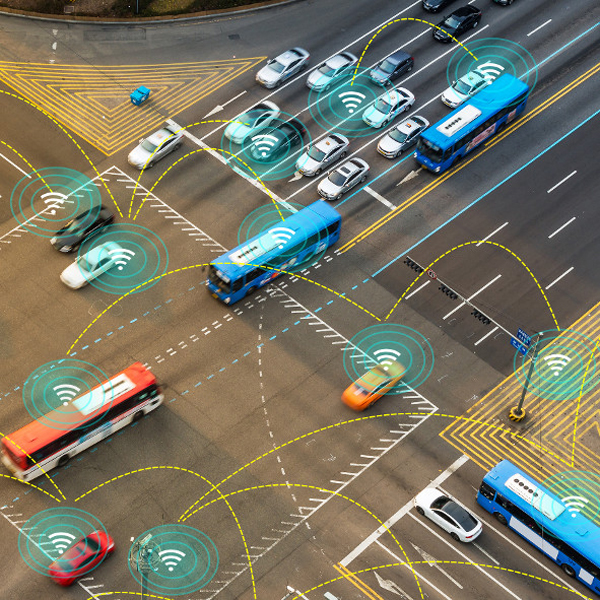Connected cars are vehicles that are able to connect with different services, devices or other connected cars over a network. They are able to connect to smartphones, laptops, traffic signals and many more. Another important feature of connected cars is the emergency call function. This feature is able to register accidents based on the data from different sensors and automatically calls emergency hotlines. It is also called eCall in the European Union and all new car models, approved for manufacture after 31 March 2018, must have the emergency call function installed.

Communication Systems
DSRC and C-V2X
Reliable networks for connected cars can only be established with powerful telematic systems. Dedicated short-range communication (DSRC) and cellular vehicle to everything communication (C-V2X) are the most promising systems that are able to handle the workload while still staying fail-safe.
DSRC is based on the newest wifi standard and tailored to the needs of the automotive industry. It is a highly secure and high-speed communication channel that is able to see around corners and operate in extreme weather conditions. The main goal of DSRC is a seamless communication between vehicles and roadside infrastructure.
Cellular-V2X is a relatively new worldwide standard by the 3rd Generation Partnership Projects (3GPP) using cellular standards of the fourth and fifth generation (4G and 5G). It enables direct communication between road users and infrastructure to ensure a more fluent traffic flow and more traffic safety. C-V2X uses the same spectrum like DSRC for the communication between two devices but is also able to connect to cellular frequencies.
At the moment it is not clear which of these two technologies is going to be used for connected cars in the future. It could be either of them or a combination of both of them. Automakers from different countries could also use different technologies based on the country’s infrastructure.

Vehicle-to-Everything (V2X)
While the concept of the “Connected Car” is not new in the automotive industry, the necessary technologies and communication standards have only been made available in the last few years. The vehicle to everything communication (V2X) is the umbrella term for the following categories of communication technologies that are needed for connected cars.
Vehicle to Network (V2N)
The V2N communication allows vehicles to connect to cellular networks and therefore also the communication with the V2X system. Because of the vehicle to network connectivity vehicles are becoming a device, just like smartphones and tablets. V2N allows cars a reliable interaction with other vehicles, devices, pedestrians and important infrastructure.
Vehicle to Infrastructure (V2I)
V2I communication is an important part of intelligent transportation systems (ITS) and allows bidirectional communication between cars and roadside infrastructure. It includes detailed data about the traffic gathered by different vehicles, data from sensors used in infrastructure like traffic lights, cameras, parking meters and broadcasted data like weather conditions, speed limits and road conditions. The main goal of this communication is to enhance safety and prevent accidents with real-time information for the drivers. But this information gets even more important in the future, when autonomous vehicles get available to the public.
Vehicle to Vehicle (V2V)
The V2V communication enables different vehicles to connect to each other. Because this communication is done wirelessly with DSRC frequencies it works similar to a mesh network. Its main advantage is that every car becomes a node and can therefore capture and send data and even retransmit data from other cars. This system allows the cars to get a 360 degree representation of the surroundings (about 300m radius) in real-time. Because of this overview it is able to inform drivers of other cars or autonomous vehicles. This overview could include information like speed, destinations and locations of traffic jams or accidents. V2V communication enhances road safety and could, according to NHTSA, prevent more than 600.000 accidents in the United States per year.
Vehicle to Cloud (V2C)
V2C communication uses the access to cellular networks to exchange data with the cloud. This data could include navigation services depending on the current traffic situation, remote diagnostic for car maintenance, over the air (OTA) updates for the vehicles software and communication with internet of things devices or digital assistants. V2C could also play an important role in carsharing in the future. The car from the carsharing service could download the drivers preferences and automatically adjust seat, mirrors, ambient lights and music playlists according to his past usages of the service.
Vehicle to Pedestrian (V2P)
The V2P communication is one of the newest and probably also hardest technologies to master. Its main goal is the reduction of accidents with pedestrians. While the other categories allow communication with smart sensors in different objects and devices, pedestrians and children are not wearing sensors to create awareness about their presence. That is the reason why automakers are currently using systems like LiDAR, 360 degree cameras and blind spot warning to detect pedestrians and cyclists. Another part of the vehicle to pedestrian communication gets more important when autonomous cars get available to the public. Currently, the driver can signal pedestrians that they are able to cross the street but if there is no driver left the autonomous car has to communicate with the pedestrian as well.
Vehicle to Device (V2D)
V2D is one of the most popular and well known communication categories. It allows vehicles to exchange data with smart devices, usually via Bluetooth. The most popular applications of this technology are Apple CarPlay and Android Auto. They allow smartphones, tablets and smart watches to seamlessly interact with the vehicles infotainment system and are already available in a lot of different cars.
Vehicle to Grid (V2G)
The V2G communication is especially useful for all electrified vehicles. It allows bidirectional data exchange between the different types of electric vehicles (PHEV, BEV, FCEV) and the smart grid. V2G will allow the next-gen electric grid to balance loads more efficiently, reduce utility bill costs and shorten waiting times.

Current state of In-Car Infotainments
Connected cars are also transforming the in-car experiences like never before. While digital interfaces are still tiny and have a horrible usability in a lot of cars, some automakers are already improving their in-vehicle infotainment systems and therefore also the whole in-car experience.
Tesla
Despite Tesla being known for their tech-first approach and their great software, their in-car infotainment is actually not that great if you take a closer look. Tesla’s car interface will be great somewhen in the future, when the cars are driving autonomously but not at the moment. The Model 3 for example has only one large screen in the center of the cockpit. There are nearly no additional buttons, switches or levers. Everything is displayed and controlled on the huge display. The driver has to look at the screen for every interaction and therefore also has to take the eyes off the road. One Tesla owner in Germany even recently (August 2020) got a one month driving ban because he crashed into trees while trying to change the speed of his windshield wipers.
Because the infotainment system of the Model 3 just got a huge UI Update (2020.48.26) in the last weeks, there is no up-to-date video about the detailed functionality of the new version. There is only a video about the previous version of the software. But while the new interface looks a lot nicer now, it still has a similar functionality. The windshield wiper settings for example now got a dedicated button in the bar on the bottom. Detailed changes will be analyzed and published by a lot of Tesla Model 3 owners soon.
Mercedes Benz
Because the first version of Mercedes MBUX was already a good system with multiple screens and a decent experience, especially for such an old and traditional company, there were high hopes for the following generations of MBUX. While the visual style may look outdated to some designers, the functionality was still a huge step forward in the right direction and created an advantage over infotainment systems of similar brands. The second generation of MBUX will be released alongside the new S-Class and started shipping a few weeks ago. Because of this there is currently no full review of the new infotainment system..
Mercedes also recently announced another new version of the MBUX infotainment system for the upcoming EQS. The EQS will be the electric counterpart of the new S-Class and is announced for later this year.
Porsche
Porsche’s first electric car, the Porsche Taycan, also has a completely new infotainment system. Because the Volkswagen group has just recently started to create their own infotainment software in-house and plans on hiring 10.000 designers, analysts and engineers to build one platform for all subsidiaries, the Porsche Taycan Infotainment is still using another system. (https://www.kurbos.com/de/projekt/porsche)
The Taycan infotainment is minimalistic, well structured and also usable. This infotainment has one main goal – supporting the user. While it currently is one of the best infotainment systems on the market, the lower central screen can also lead to a lot of driver distraction and therefore also decrease the safety.

A detailed UX evaluation of the Porsche Taycan infotainment is available here:
https://www.sbdautomotive.com/en/porsche-taycan-ux
Conclusion
Creating the perfect in-car infotainment system is nearly impossible, but a lot of different automakers are already working on improving their in-car experience. While there is no perfect system at the moment, there are a lot of different good solutions for specific problems available. Each system has unique advantages and disadvantages. The main goal of the next generation in-vehicle interfaces should be to provide a safe, usable and enjoyable experience for the driver and passengers. With the release of new electric vehicles like the Lucid Air, Byton M-Byte and Rivian R1S in Europe later this year, the development of in-car experiences will get more and more interesting and competitive in the upcoming years. Another interesting change for in-vehicle infotainment systems will be the change from human drivers to autonomous vehicles.

Resources | part 1
https://www.bmw.com/de/innovation/connected-car.html
https://www.everythingrf.com/community/what-is-dsrc
https://www.mes-insights.com/what-is-dsrc-dedicated-short-range-communications-a-931536/
https://www.ip-insider.de/was-ist-cellular-v2x-c-v2x-a-943952/
https://blog.rgbsi.com/7-types-of-vehicle-connectivity
https://uxdesign.cc/the-state-of-automotive-in-car-user-experience-in-2020-57cc307abd9c